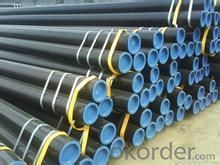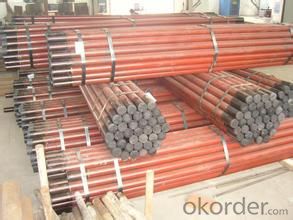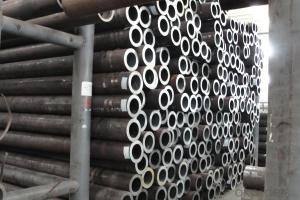60mm-102mm Drill Pipe & API Drill Rod
- Loading Port:
- China Main Port
- Payment Terms:
- TT or LC
- Min Order Qty:
- 25MT m.t.
- Supply Capability:
- 1000MT m.t./month
OKorder Service Pledge
OKorder Financial Service
You Might Also Like
1. Process of High Quality Drill Rod
1). The performance and advantages: rod tube ends inside and outside thicker type, the joint use of phosphate or plated steel threaded processing.
2). The product uses: down hole drilling operations, to extend the drill footage;
3). Service: home delivery, tracking services;
4). Packing: steel strapping, compartment plate press-fit.
2. Specification High Quality Drill Rod
Size | Normal | Calculated Plain-End weight | Grade | Outside Diam. | Wall Thickness | Upset type | Tool Joint | ||||
in | mm | Lb/ft | Lb/ft | kg/m | Inch | mm | Inch | mm | |||
2-3/8 | 60.3 | 6.65 | 6.26 | 9.32 | E,X,G,S | 2.375 | 60.3 | 0.28 | 7.11 | EU | NC26 |
2 7/8 | 73 | 10.4 | 9.72 | 14.48 | E,X,G,S | 2.875 | 73 | 0.362 | 9.19 | EU IU | NC31 |
3 1/2 | 88.9 | 9.5 | 8.81 | 13.12 | E | 3.5 | 88.9 | 0.254 | 6.45 | EU IU | NC38 |
3 1/2 | 88.9 | 13.3 | 12.31 | 18.34 | E,X,G,S | 3.5 | 88.9 | 0.368 | 9.35 | EU IU | NC38,NC40 |
3 1/2 | 88.9 | 15.5 | 14.63 | 21.79 | E | 3.5 | 88.9 | 0.449 | 11.4 | EU IU | NC38,NC40 |
3 1/2 | 88.9 | 15.5 | 14.63 | 21.79 | X,G,S | 0.449 | 11.4 | EU IEU | |||
4 | 101.6 | 14 | 12.93 | 19.26 | E,X,G,S | 4 | 101.6 | 0.33 | 8.38 | EU IU | NC40,NC46 |
4-1/2 | 114.3 | 13.75 | 12.24 | 18.23 | E | 4.5 | 114.3 | 0.271 | 6.88 | EU IU | NC46,NC50 |
4-1/2 | 114.3 | 16.6 | 14.98 | 22.31 | E,X,G,S | 4.5 | 114.3 | 0.337 | 8.56 | EU IEU | NC46,NC50 |
4-1/2 | 114.3 | 20 | 18.69 | 27.84 | E,X,G,S | 4.5 | 114.3 | 0.43 | 10.92 | EU IEU | NC46,NC50 |
5 | 127 | 16.25 | 14.87 | 22.15 | X,G,S | 5 | 127 | 0.296 | 7.52 | IU | NC50.5,1/2FH |
5 | 127 | 19.5 | 17.93 | 26.71 | E | 5 | 127 | 0.362 | 9.19 | IEU | NC50.5,1/2FH |
5 | 127 | 19.5 | 17.93 | 26.71 | X,G,S | 5 | 127 | 0.362 | 9.19 | EU IEU | NC50.5,1/2FH |
5 | 127 | 25.6 | 24.03 | 35.79 | E | 5 | 127 | 0.5 | 12.7 | IEU | NC50.5,1/2FH |
5 | 127 | 25.6 | 24.03 | 35.79 | X,G,S | 5 | 127 | 0.5 | 12.7 | EU IEU | NC50.5,1/2FH |
3.Strength High Quality Drill Rod
Grade | Yield Strength | Tensile strength | |||||
min | max | min | |||||
Psi | Mpa | Psi | Mpa | Psi | Mpa | ||
1 | E-75 | 75 | 517 | 105 | 724 | 100000 | 689 |
2 | X-95 | 95 | 655 | 125 | 862 | 105000 | 724 |
G-105 | 105 | 724 | 135 | 931 | 115000 | 793 | |
S-135 | 135 | 931 | 165 | 1138 | 145000 | 1000 | |
4.FAQ of High Quality Drill Rod:
①How is the quality of your products?
Our products are manufactured strictly according to national and internaional standard. Guaranteed: If products’ quality don’t accord to discription as we give or the promise before you place order, we promise 100% refund.
②How about price?
Yes, we are factory and be able to give you lowest price below market one, and we have a policy that “ for saving time and absolutely honest business attitude, we quote as lowest as possible for any customer, and discount can be given according to quantity.
③Why should you chose us?
We believe that good quality+good price+good service=customer’s trust
SGS test is available, customer inspection before shipping is welcome, third party inspection is no problem.
6、High Quality Drill Rod Images:


- Q:Can steel pipes be coated for aesthetic purposes?
- Yes, steel pipes can be coated for aesthetic purposes. Coating steel pipes not only adds a visually appealing finish but also provides protection against corrosion and other environmental factors. There are various coating options available for steel pipes, such as powder coating, epoxy coating, and vinyl coating, among others. These coatings can be applied in different colors and textures to enhance the appearance of the pipes and complement the surrounding environment. Whether in industrial settings, architectural projects, or decorative applications, coating steel pipes can transform them into visually appealing elements while maintaining their structural integrity.
- Q:What are the industries that commonly use steel pipes?
- Some of the industries that commonly use steel pipes include oil and gas, construction, manufacturing, automotive, infrastructure, water treatment, and plumbing.
- Q:What are the different methods of bending steel pipes?
- There are several methods of bending steel pipes, including hot bending, cold bending, mandrel bending, rotary draw bending, and induction bending.
- Q:How do you determine the required wall thickness for steel pipes?
- The required wall thickness for steel pipes is determined through various factors and calculations. One of the primary considerations is the pressure that the pipe will be subjected to. The higher the pressure, the thicker the wall needs to be to ensure the pipe can withstand the internal forces. Another important factor is the material strength of the steel used for the pipe. Different grades of steel have varying tensile strengths, which affect the required wall thickness. The tensile strength is the maximum amount of stress a material can withstand before it fails, so it is crucial to select a steel grade that can handle the expected pressure. Additionally, the pipe's diameter plays a role in determining the required wall thickness. Larger diameter pipes generally require thicker walls to maintain structural integrity and prevent deformation under pressure. To calculate the required wall thickness, engineers use industry standards and formulas. The most commonly used standard is the American Society of Mechanical Engineers (ASME) B31 code, which provides guidelines for designing pressure piping systems. The ASME code incorporates factors such as safety margins, material properties, and pressure ratings to determine the appropriate wall thickness. Furthermore, other considerations such as temperature, corrosion, and external loads may also influence the required wall thickness. For example, high-temperature applications may require thicker walls to prevent the pipe from buckling or becoming too soft. In summary, determining the required wall thickness for steel pipes involves considering factors such as pressure, material strength, diameter, temperature, and other external forces. Engineers rely on industry standards and calculations to ensure the pipe can withstand the intended operating conditions safely.
- Q:What are the different testing methods for steel pipes?
- Some of the different testing methods for steel pipes include non-destructive testing methods such as ultrasonic testing, magnetic particle testing, and radiographic testing. These methods are used to detect any defects or inconsistencies in the pipe's structure or material without causing any damage. Other testing methods include hydrostatic testing, which involves pressurizing the pipe with water to check for leaks or weaknesses, and mechanical testing, which measures the pipe's strength and durability through tensile, hardness, and impact tests.
- Q:What are the different joining methods for steel pipes?
- There are several joining methods for steel pipes, including welding, threaded connections, flanged connections, and mechanical couplings. Welding involves melting the ends of the pipes and fusing them together using heat. Threaded connections involve screwing the pipes together using threaded ends. Flanged connections use flanges that are bolted together to connect the pipes. Mechanical couplings use a variety of methods such as compression fittings or grooved couplings to connect the pipes without welding or threading.
- Q:How are steel pipes used in the manufacturing of aerospace components?
- Steel pipes are used in the manufacturing of aerospace components as they provide structural support and durability. They are commonly used for fuel and hydraulic systems, allowing for the safe and efficient transfer of fluids throughout the aircraft. Additionally, steel pipes are utilized in the fabrication of engine components and airframe structures, ensuring strength and reliability in the demanding aerospace environment.
- Q:What's the gate number of the precision steel pipe?
- This kind of steel tube and ordinary hot-rolled seamless steel pipe and cold drawn seamless steel tube in the outer surface is different from the outer surface, and the diameter of the smooth finish of precision steel tube, stainless steel color and the same, inside and outside surface due to manufacturing reasons with a layer of oil.
- Q:How are steel pipes insulated for thermal purposes?
- Steel pipes are insulated for thermal purposes by wrapping them with insulating materials such as mineral wool, fiberglass, or foam. These insulating materials help to prevent heat transfer between the pipe and its surroundings, minimizing energy loss and maintaining the desired temperature inside the pipe. Additionally, a protective outer layer or jacket is often applied to enhance the insulation's durability and protect it from external elements.
- Q:What are the different types of joints used in steel pipes?
- The different types of joints used in steel pipes include butt weld, socket weld, threaded, and flanged joints.
1. Manufacturer Overview |
|
|---|---|
| Location | |
| Year Established | |
| Annual Output Value | |
| Main Markets | |
| Company Certifications | |
2. Manufacturer Certificates |
|
|---|---|
| a) Certification Name | |
| Range | |
| Reference | |
| Validity Period | |
3. Manufacturer Capability |
|
|---|---|
| a)Trade Capacity | |
| Nearest Port | |
| Export Percentage | |
| No.of Employees in Trade Department | |
| Language Spoken: | |
| b)Factory Information | |
| Factory Size: | |
| No. of Production Lines | |
| Contract Manufacturing | |
| Product Price Range | |
Send your message to us
60mm-102mm Drill Pipe & API Drill Rod
- Loading Port:
- China Main Port
- Payment Terms:
- TT or LC
- Min Order Qty:
- 25MT m.t.
- Supply Capability:
- 1000MT m.t./month
OKorder Service Pledge
OKorder Financial Service
Similar products
New products
Hot products
Hot Searches
Related keywords





























